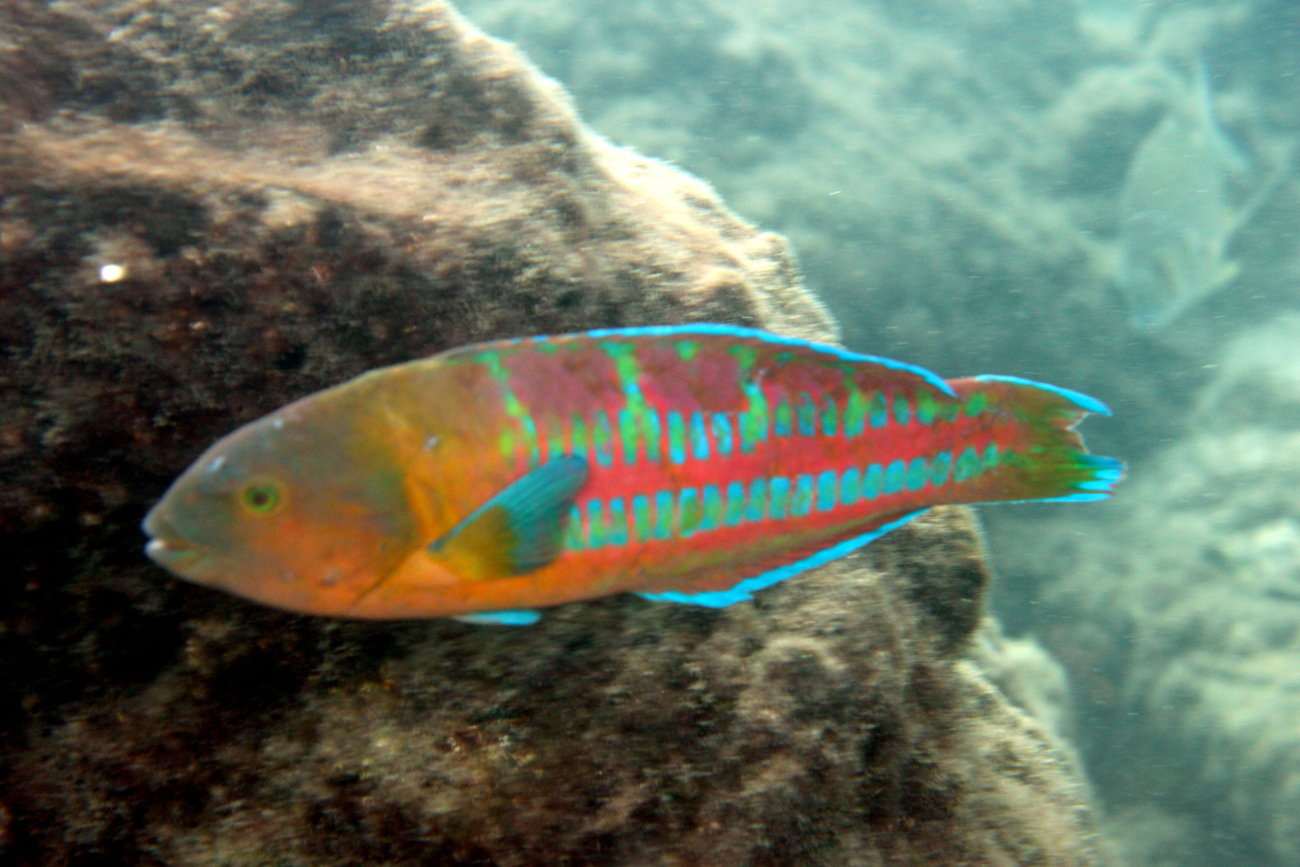- Classification
- ACTINOPTERYGII
- PERCIFORMES
- LABRIDAE
- Thalassoma
- trilobatum
Ladder Wrasse, Thalassoma trilobatum (Lacépède 1801)

A Ladder Wrasse, Thalassoma trilobatum, on the Gold Coast Seaway, southern Queensland, December 2011. Source: debaston / iNaturalist.org. License: CC by Attribution-NonCommercial
Often confused with the Surge Wrasse, Thalassoma purpureum.
Ladder Wrasse, Thalassoma trilobatum (Lacépède 1801)
More Info
|
Distribution |
Known in Australian waters from Rowley Shoals to Ashmore Reef, WA, and north of Cape York, QLD to northern, NSW; also Cocos (Keeling), Christmas and Lord Howe islands, and Elizabeth and Middleton Reefs. Elsewhere, widespread in the tropical, Indo-west-central Pacific, from East Africa in the Indian Ocean, to the Pitcairn Islands, the Ryukyu Islands and Rapa Island in the Pacific. Inhabits exposed reef flats and reef margins, with mixed coral, algae and seagrass. |
|
Features |
Dorsal fin VIII, 12-14; Anal fin III, 10-12. |
|
Feeding |
Feeds on a range of benthic invertebrates, including crabs, molluscs and brittle stars. |
|
Biology |
Protogynous hermaphrodites, capable of changing sex from female to male during their life cycle. Usually occurs in groups or harems with a single male. |
|
Similar Species |
Very similar to the Surge Wrasse, Thalassoma purpureum. Females of both species are almost identical, differing slightly in head length and colouration. The Surge Wrasse has a slightly longer head, with a V-shaped mark on the snout. Female Ladder Wrasse have spotted head and lack the 'V-shaped' mark. Male Surge Wrasse have a greenish to bluish head with a pinkish mark above the upper lip, and the snout mostly pinkish to purplish. Male T. trilobatum have a plain brownish to orange or bluish head. |
|
Species Citation |
Labrus trilobatus Lacépède, 1801, Hist. Nat. Poiss.: 454, 526, pl. 4(3). Type locality: Mauritius. |
|
Author |
Bray, D.J. 2017 |
Ladder Wrasse, Thalassoma trilobatum (Lacépède 1801)
References
Allen, G.R. 1997. Marine Fishes of Tropical Australia and South-east Asia. Perth : Western Australian Museum 292 pp. 106 pls.
Allen, G.R. & Erdmann, M.V. 2012. Reef fishes of the East Indies. Perth : Tropical Reef Research 3 vols, 1260 pp.
Allen, G.R., Steene, R.C. & Orchard, M. 2007. Fishes of Christmas Island. Christmas Island : Christmas Island Natural History Association 2 edn, 284 pp.
Allen, G.R. & Smith-Vaniz, W.F. 1994. Fishes of Cocos (Keeling) Islands. Atoll Research Bulletin 412: 1-21
Bernardi, G., Bucciarelli, G., Costagliola, D., Robertson, D.R. & Heiser, J.B. 2004. Evolution of coral reef fish Thalassoma spp. (Labridae). 1. Molecular phylogeny and biogeography. Marine Biology 144: 369-375, 405
Cabanban, A. & Pollard, D. 2010. Thalassoma trilobatum. In: IUCN 2012. IUCN Red List of Threatened Species. Version 2012.2.
Choat, J.H., van Herwerden, L., Robbins, W.D., Hobbs, J.P. & Ayling, A.M. 2006. A report on the ecological surveys undertaken at Middleton and Elizabeth Reefs, February 2006. Report by James Cook University to the Department of the Environment and Heritage. 65 pp.
Francis, M. 1993. Checklist of the coastal fishes of Lord Howe, Norfolk, and Kermadec Islands, southwest Pacific Ocean. Pacific Science 47(2): 136-170 figs 1-2
Hutchins, J.B. 2001. Biodiversity of shallow reef fish assemblages in Western Australia using a rapid censusing technique. Records of the Western Australian Museum 20: 247-270
Johnson, J.W. 1999. Annotated checklist of the fishes of Moreton Bay, Queensland, Australia. Memoirs of the Queensland Museum 43(2): 709-762
Kuiter, R.H. 1993. Coastal Fishes of South-eastern Australia. Bathurst : Crawford House Press 437 pp.
Lacépède, B.G. 1801. Histoire Naturelle des Poissons. Paris : chez Plassan Vol. 3 558 pp. 34 pls.
Oxley, W.G., Ayling, A.M., Cheal, A.J. & Osborne, K. 2004. Marine surveys undertaken in the Elizabeth and Middleton Reefs Marine National Nature Reserve, December 2003. Townsville : Australian Institute of Marine Sciences 64 pp.
Randall, J.E., Allen, G.R. & Steene, R. 1990. Fishes of the Great Barrier Reef and Coral Sea. Bathurst : Crawford House Press 507 pp. figs.
Randall, J.E., Allen, G.R. & Steene, R. 1997. Fishes of the Great Barrier Reef and Coral Sea. Bathurst : Crawford House Press 557 pp. figs.
Westneat, M.W. 2001. Labridae. pp. 3381-3467 in Carpenter, K.E. & Niem, T.H. (eds). The Living Marine Resources of the Western Central Pacific. FAO Species Identification Guide for Fisheries Purposes. Rome : FAO Vol. 6 3381-4218pp.








